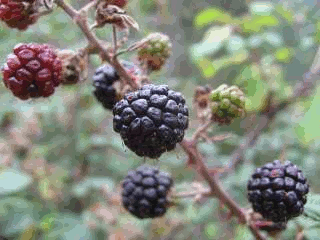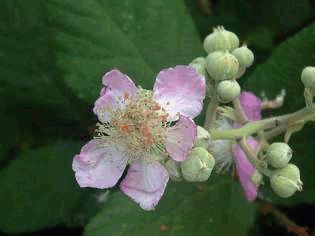Elmleaf Blackberry
Common Names: Elmleaf blackberry, thornless blackberry
Scientific Name: Rubus ulmifolius.
Climate: Temperate, Cold.
 Plant Description: The blackberry is a semi-deciduous shrub that extends in the shape of brambles and grows about 5 meters tall. It has a pentagonal trunk; the stems are low arched and intertwined, clearly whitish turning reddish, angular. The stems have few or many thick spines, erect or slightly hooked at the corners. The young stems are velvety. Its leaves are unevenly distributed on the stem; they are oval in shape with a serrated edge, and are composed of 3 or 5 leaflets. The leaflets are green on the upper surface but white on the underside due to a dense coat of woolly hairs. The flowers are hermaphroditic, white or pink, with five petals and five sepals, and have numerous stamens that attract bees. They are born in clusters, giving rise to oblong or pyramidal inflorescences. The sepals are gray or tomentose-whitish. Its fruit is a polydrupe, several drupes together; greenish at the beginning that turns red later and turns black with maturation. They are smooth, juicy, sweet and salty.
Plant Description: The blackberry is a semi-deciduous shrub that extends in the shape of brambles and grows about 5 meters tall. It has a pentagonal trunk; the stems are low arched and intertwined, clearly whitish turning reddish, angular. The stems have few or many thick spines, erect or slightly hooked at the corners. The young stems are velvety. Its leaves are unevenly distributed on the stem; they are oval in shape with a serrated edge, and are composed of 3 or 5 leaflets. The leaflets are green on the upper surface but white on the underside due to a dense coat of woolly hairs. The flowers are hermaphroditic, white or pink, with five petals and five sepals, and have numerous stamens that attract bees. They are born in clusters, giving rise to oblong or pyramidal inflorescences. The sepals are gray or tomentose-whitish. Its fruit is a polydrupe, several drupes together; greenish at the beginning that turns red later and turns black with maturation. They are smooth, juicy, sweet and salty.
They are native to Europe and North Africa
Cultivation: Plant in full sun. If the region is very hot, it is recommended to plant in semi-shade. The plant prefers well-drained moist, acidic or basic soils. The blackberry is very resistant to temperatures, it is found from sea level to more than a thousand meters high in a wide range of climates.
The blackberry should be planted in a place where it cannot become invasive, that is, a space is needed where it can be easily managed. In order to successfully manage the cultivation, the blackberry - being a climbing plant - needs a trellis to support it.
Blackberry is propagated by layering or cuttings.
Propagation by layering: it should be done on long stems (1.5 to 2.5m) that are healthy; each stem is extended into the ground, burying portions of the stem approximately every 25 cm to favor root development. After a month or a month and a half, the layers should be separated from the mother plant, keeping them in the same conditions for another 15 to 30 days. With this method you can get 3-5 plants per branch.
Propagation by cuttings: this method consists of obtaining 35 cm portions of vigorous flower stems that have already finished their harvest. The diameter of these stems must be at least 1 cm and each cuttings must have 3 to 4 buds. Once the stake is obtained, a round cut is made under a bud - this part is for rooting. A bevel is made on top of the third bud - so when it rains the plant irrigates well. The cuttings are soaked in water with cinnamon and panela (raw cane sugar) for 24 hours so that the stakes are sufficiently moist for the planting. Cinnamon and panela serve to prevent Botrytis. Blackberries need heat to root. To do this, prepare a plastic bottle cut in half, leaving the top partially attached to the rest of the bottle. Holes are made in the base and the bottle is filled with the moistened compost. Before placing the stakes, cinnamon powder is put on the two cut points. 4 stakes with the round part and the spines inclined downwards are placed in the bottle. The top is closed. The cuttings will root in a short period of time but in order to have strong roots it is better to leave them grow for several weeks. Transplant them in the place where you can put support for the blackberry to climb. The soil must be well drained. Remove from the bottle and put all the 4 cuttings that are together in the same hole.
It is recommended that the watering be frequent and short, especially during the flowering and fruit setting season, which is when watering becomes essential.
It is essential to guard the plants for an easy harvest. The pruning of the plants that have already produced their fruit is done in the winter, leaving the one-year plants to produce the next season. It is recommended to leave about 30 cm between rods when pruning, choosing the most vigorous.
The berries are black when they are ripe, if it is harvested frequently the plant will bloom more and produce more fruit. When the plant is ready to bear fruit, cut the new shoots from the base of the plant. Do not harvest the fruit when they are wet.
 Uses: The leaf, root, and fruit (berry) are used to make medicine. Mulberry is used to treat diarrhea, fluid retention, diabetes, gout, and pain and swelling (inflammation); and to prevent cancer and heart disease. It is also used as a mouthwash for mild irritation of the mouth and throat.
Uses: The leaf, root, and fruit (berry) are used to make medicine. Mulberry is used to treat diarrhea, fluid retention, diabetes, gout, and pain and swelling (inflammation); and to prevent cancer and heart disease. It is also used as a mouthwash for mild irritation of the mouth and throat.
The blackberry is a source of mineral salts, vitamins, and antioxidants. They are fruits of low caloric value due to their low contribution of carbohydrates, which makes them a beneficial food that helps metabolism. They are especially rich in vitamin C, containing even greater amounts than some citrus fruits. They contain manganese, vitamins A, B and K, potassium, and dietary fiber. The consumption of blackberries strengthens the immune system and bones, invigorates the heart, and helps in intestinal diseases.
Pests and Diseases: The plant can contract various types of fungi if it is too wet for a long time. These can survive cold weather, so it is best to remove and destroy the infected part. Wounds from pruning or other damage can also become infected.
Spider mite - It is recommended to avoid substrates with excess nitrogen and to monitor crops during the early stages of development. In fairly dry climates it is recommended to water the crops at night to maintain humidity. To combat an infestation, an extract of garlic and chili can be applied. If the plant is badly affected, it is best to remove it to prevent it from spreading to other plants.
Thrips - To combat them ecological alternatives such as potassium soap and neem extract can be used. To prevent:, blue or yellow traps or containers with sticky surfaces are placed so that the thrips remain adhered to them. Biological control can be carried out through its natural enemies. Thrips have several natural predators such as certain varieties of mites, especially Amblyseius barkeri and the Orius bug.
Gray rot (Botrytis cinerea) - a parasite that can lead to the death of the plant. The main sources of inoculum are conidia and plant debris that are dispersed by the wind. It develops between 17 and 23ºC, with a relative humidity of 95%. To prevent Botrytis it is important to control the nitrogen and calcium levels in the soil, remove the plants that have already been affected by the disease and take special care in pruning, making clean cuts flush with the stem and, if possible, when the relative humidity is not very high.
Downy mildew (Phytophthora infestations) - The dispersion of the fungus is carried out by rain and wind, sprinkler irrigation, dew and condensation drops. For its prevention, it is recommended to remove the plants that have already been affected by the disease and make proper management of ventilation and irrigation. It is also recommended to use healthy seedlings.
References:
Proyecto Cultivos Urbanos, Colombia. http://www.proyectocultivosurbanos.com/nosotros/
https://www.sembrar100.com/arboles/zarzamora/#Como_sembrar_zarzamora_paso_a_paso
En Espanol: Zarzamora
